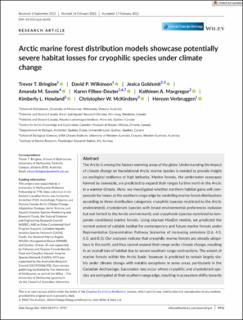| dc.description.abstract | The Arctic is among the fastest-warming areas of the globe. Understanding the impact of climate change on foundational Arctic marine species is needed to provide insight on ecological resilience at high latitudes. Marine forests, the underwater seascapes formed by seaweeds, are predicted to expand their ranges further north in the Arctic in a warmer climate. Here, we investigated whether northern habitat gains will compensate for losses at the southern range edge by modelling marine forest distributions according to three distribution categories: cryophilic (species restricted to the Arctic environment), cryotolerant (species with broad environmental preferences inclusive but not limited to the Arctic environment), and cryophobic (species restricted to temperate conditions) marine forests. Using stacked MaxEnt models, we predicted the current extent of suitable habitat for contemporary and future marine forests under Representative Concentration Pathway Scenarios of increasing emissions (2.6, 4.5, 6.0, and 8.5). Our analyses indicate that cryophilic marine forests are already ubiquitous in the north, and thus cannot expand their range under climate change, resulting in an overall loss of habitat due to severe southern range contractions. The extent of marine forests within the Arctic basin, however, is predicted to remain largely stable under climate change with notable exceptions in some areas, particularly in the Canadian Archipelago. Succession may occur where cryophilic and cryotolerant species are extirpated at their southern range edge, resulting in ecosystem shifts towards temperate regimes at mid to high latitudes, though many aspects of these shifts, such as total biomass and depth range, remain to be field validated. Our results provide the first global synthesis of predicted changes to pan-Arctic coastal marine forest ecosystems under climate change and suggest ecosystem transitions are unavoidable now for some areas. | en_US |
